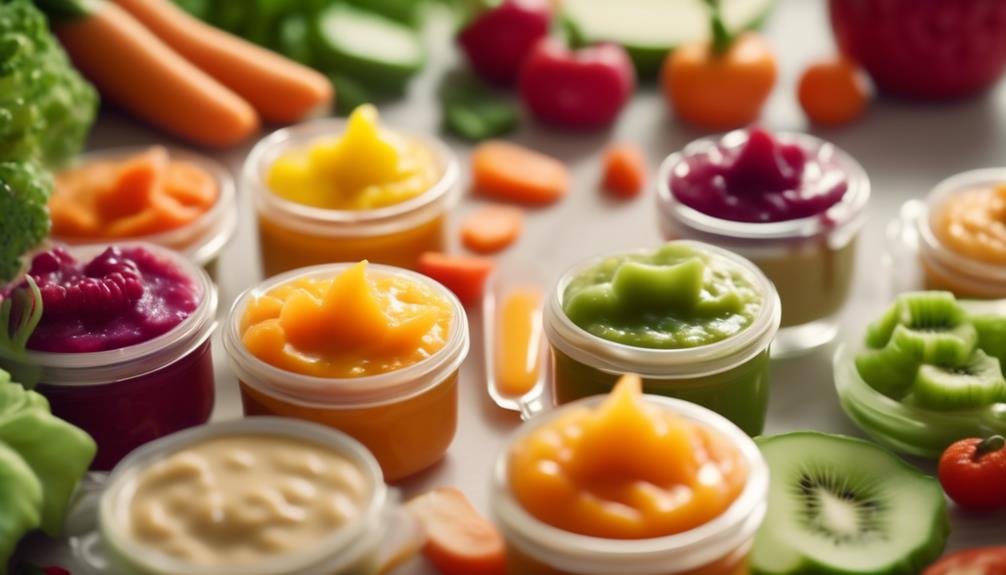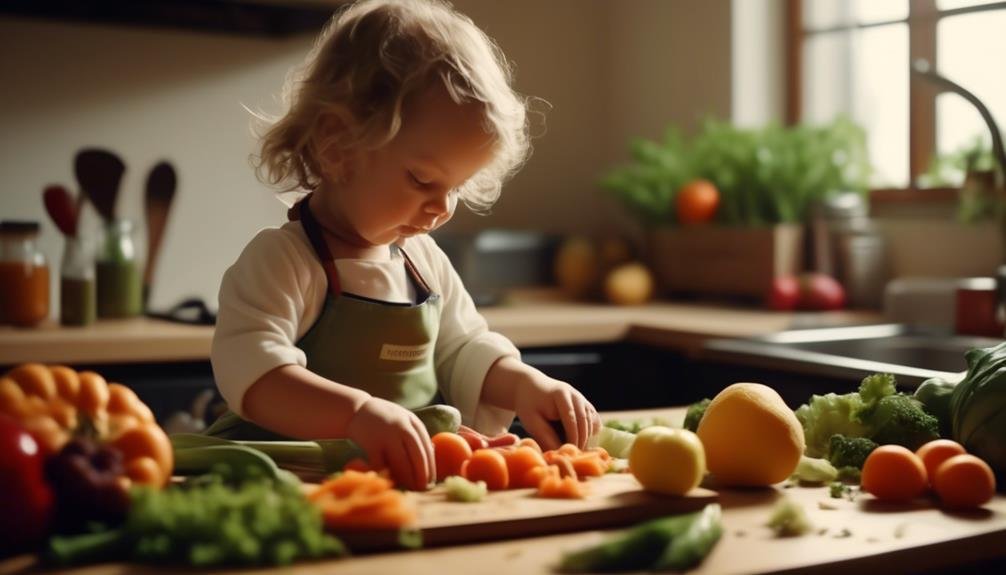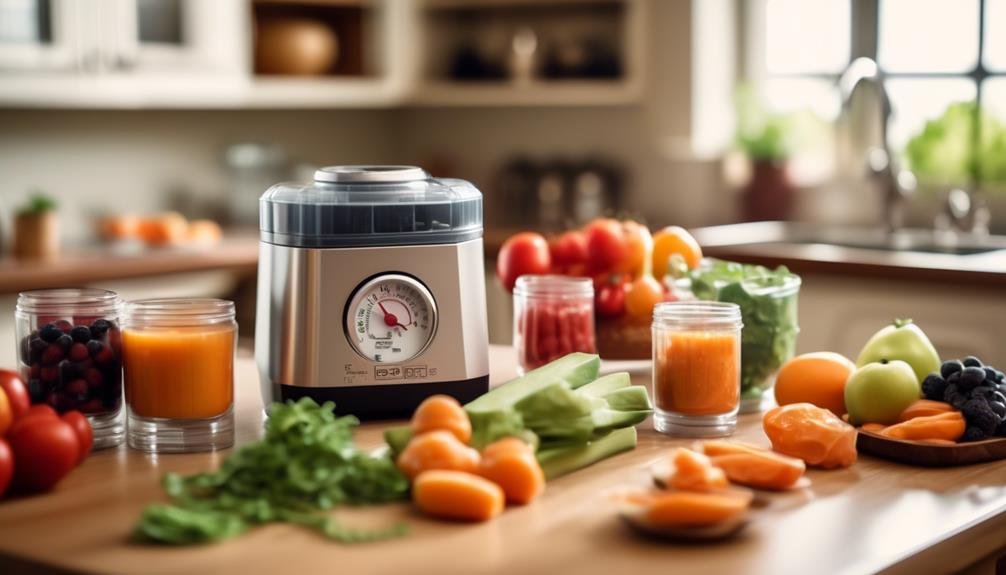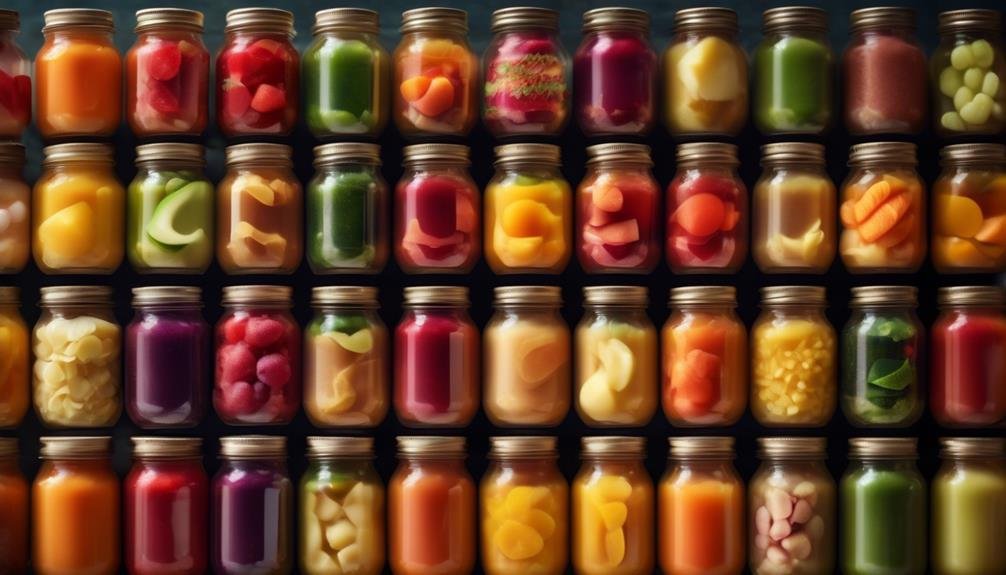"Cherishing Little Steps - A Haven for Baby and Family Journeys"
Homemade Baby Food Basics
Imagine being at a dinner party, where everyone is raving about the delectable dishes served. As you savor each bite, you can't help but wonder how these tantalizing flavors could be created at home.
Well, just like a skilled chef, you too can create mouthwatering meals for your little one with homemade baby food. But where do you start? How do you ensure that your baby is getting the best nutrition possible?
In this discussion, we will explore the basics of homemade baby food, from choosing the right ingredients to proper food preparation techniques, and even introducing new flavors and textures. Get ready to embark on a culinary adventure that will delight both your baby's taste buds and your inner chef.
Key Takeaways
- Complete control over ingredients
- Freshest and most nutritious foods
- Customizable flavors and textures
- Cost savings compared to pre-packaged baby foods
Benefits of Homemade Baby Food

Making your own baby food can provide numerous benefits for both you and your baby. One of the main advantages is the nutritional advantage. When you prepare homemade baby food, you have complete control over the ingredients you use. This allows you to ensure that your baby is getting the freshest and most nutritious foods possible. You can choose to use organic fruits and vegetables, which are free from harmful pesticides and chemicals. Additionally, you can customize the flavors and textures to suit your baby's preferences and developmental needs.
Another benefit of making your own baby food is the cost savings. Pre-packaged baby foods can be quite expensive, especially if you opt for organic options. By making your own, you can save a significant amount of money in the long run. Just think about it, a bag of organic carrots can yield multiple servings of baby food, whereas a jar of store-bought baby food typically only contains a single serving.
Choosing the Right Ingredients
To ensure that your homemade baby food is nutritious and safe for your baby, it's important to carefully choose the right ingredients. Following nutrition guidelines is crucial when selecting ingredients for your baby's meals. It's recommended to include a variety of fruits, vegetables, whole grains, and lean proteins to provide a well-rounded diet. Opt for organic options whenever possible, as they're grown without the use of harmful pesticides and chemicals, reducing your baby's exposure to potential toxins. Organic fruits and vegetables also tend to have higher nutrient content compared to conventionally grown produce.
When purchasing ingredients, pay attention to their quality and freshness. Select fruits and vegetables that are firm, vibrant in color, and free from spots or bruises. Use locally sourced and seasonal produce whenever available, as they're often picked at their peak ripeness and contain more nutrients. Consider steaming or baking vegetables instead of boiling them, as this can help retain more vitamins and minerals.
Additionally, avoid adding salt, sugar, or artificial additives to your baby's food. Babies have delicate taste buds and don't need these extra flavors in their diet. Instead, focus on introducing natural flavors and textures to expand their palate.
Proper Food Preparation Techniques

Now that you have carefully chosen the right ingredients for your homemade baby food, it's important to learn proper food preparation techniques to ensure the safety and nutritional value of your baby's meals. Here are four essential food safety and cooking methods to keep in mind:
- Wash your hands: Before you start preparing baby food, always wash your hands thoroughly with soap and water. This helps to eliminate any potential bacteria or contaminants that may be present.
- Clean cooking utensils: Make sure to clean all utensils, cutting boards, and surfaces that come into contact with the baby food. Use hot, soapy water and rinse them well to remove any food residue.
- Cook food thoroughly: It's crucial to cook the baby food thoroughly to destroy any harmful bacteria. Use a food thermometer to ensure that the food reaches the appropriate internal temperature. For meats, this is usually around 165°F (74°C).
- Store food properly: After cooking, refrigerate or freeze the baby food in small, airtight containers to maintain its freshness and prevent the growth of bacteria. Label each container with the date and use it within 2-3 days if refrigerated or 1-2 months if frozen.
Age-Appropriate Foods for Babies
When introducing solid foods to your baby, it's important to choose age-appropriate options that provide the necessary nutrients for their development. One popular method of introducing solids is called baby-led weaning. This approach involves offering small, soft pieces of food that the baby can pick up and feed themselves. It encourages independent eating skills and allows the baby to explore different tastes and textures at their own pace.
When it comes to introducing allergenic foods, it's now recommended to introduce them early on, around 4 to 6 months of age, to help prevent allergies. This includes foods like peanuts, eggs, dairy, wheat, and fish. Start with small amounts and watch for any signs of an allergic reaction, such as rash, vomiting, or difficulty breathing. If your family has a history of food allergies, it's best to consult with your pediatrician before introducing these foods.
Remember to offer a variety of foods to ensure your baby receives a well-rounded diet. Include fruits, vegetables, whole grains, lean proteins, and healthy fats. It's also important to avoid added sugars, salt, and processed foods. By providing age-appropriate foods, you're helping to support your baby's growth and development while encouraging healthy eating habits from an early age.
Storing and Freezing Homemade Baby Food

You can store and freeze homemade baby food to ensure it stays fresh and ready for your baby's meals. Here are some storing tips and freezing techniques to help you keep your baby's food safe and delicious:
- Choose the right containers: Use BPA-free plastic containers, silicone storage trays, or glass jars with airtight lids. Avoid using regular ice cube trays as they may not seal properly.
- Portion control: Freeze baby food in small portions to make it easier to thaw and serve. Use 1-ounce or 2-ounce containers to prevent wastage.
- Label and date: Always label each container with the type of food and the date it was made. This will help you keep track of freshness and prevent any mix-ups.
- Proper freezing technique: To freeze baby food, allow it to cool completely before transferring it to the freezer. Fill the containers leaving some headspace for expansion. Place them in the freezer and make sure they're stored upright to prevent any leaks.
Introducing New Flavors and Textures
Introduce your baby to new flavors and textures gradually, to ensure a smooth transition and enjoyable mealtime experiences. It's important to expose your little one to a variety of tastes and textures early on, as this can help expand their palate and encourage them to be more adventurous eaters as they grow.
Start by offering simple single-ingredient purees, such as mashed banana or steamed sweet potato. As your baby becomes more comfortable with these basic flavors, you can begin to combine different ingredients to create more complex flavors.
When introducing new textures, it's best to start with smooth purees and gradually move on to mashed or finely chopped foods. This allows your baby to adjust to different consistencies and textures at their own pace.
It's also important to introduce allergens early, as research suggests that early exposure to potential allergens, such as peanuts, may actually reduce the risk of developing allergies later in life. However, it's crucial to consult with your pediatrician before introducing allergenic foods, especially if there's a family history of allergies.
Safety Tips for Homemade Baby Food

To ensure the safety of your homemade baby food, it's essential to follow proper food handling and preparation practices. Here are four important safety tips to keep in mind:
- Be aware of food allergies in babies: Introducing new foods to your baby can be exciting, but it's crucial to be mindful of potential allergies. Start by introducing one new food at a time and wait a few days before introducing another. This allows you to identify any allergic reactions and pinpoint the specific food causing it.
- Avoid common mistakes in homemade baby food preparation: One common mistake isn't washing fruits and vegetables thoroughly. Always wash them under running water to remove any dirt or potential contaminants. Additionally, ensure that your cooking utensils and equipment are properly cleaned and sanitized.
- Practice safe food storage: After preparing homemade baby food, store it in airtight containers and refrigerate or freeze it promptly. This helps prevent the growth of harmful bacteria. Remember to label and date the containers to track how long they've been stored.
- Use safe feeding practices: When feeding your baby, always use clean utensils and avoid putting the spoon back into the container after it has been in your baby's mouth. This helps prevent cross-contamination and the spread of bacteria.
Transitioning to Solid Foods
Now that you have learned the safety tips for homemade baby food, it's time to explore the next stage in your baby's culinary journey: the introduction of solid foods. One approach to transitioning to solid foods is called baby-led weaning. This method involves allowing your baby to self-feed with appropriately sized and textured foods, rather than relying solely on purees. Baby-led weaning encourages independent eating skills and helps develop hand-eye coordination.
When introducing solid foods, it's important to be aware of allergenic foods. Contrary to popular belief, research shows that introducing allergenic foods early on may actually reduce the risk of food allergies. The American Academy of Pediatrics suggests introducing allergenic foods, such as peanuts, eggs, and fish, around 4 to 6 months of age, while continuing to breastfeed or formula-feed. Start with a small amount and watch for any adverse reactions. If your baby has a family history of food allergies, consult with your pediatrician before introducing allergenic foods.
Recipes for Homemade Baby Food

Get ready to explore some nutritious and delicious recipes for homemade baby food. Making your own baby food not only allows you to control what goes into your little one's meals, but it also offers numerous benefits, including increased nutritional value and cost savings.
Here are four easy recipes to get you started:
- Sweet Potato Mash: Steam or roast sweet potatoes until tender. Mash them with a fork or blend until smooth. Sweet potatoes are rich in vitamins A and C, fiber, and antioxidants, making this a nutritious choice for your baby.
- Avocado Puree: Scoop out the flesh of a ripe avocado and blend it until smooth. Avocados are packed with healthy fats, vitamins, and minerals, providing essential nutrients for your baby's growth and development.
- Apple and Spinach Puree: Peel, core, and chop an apple. Steam the apple slices with a handful of spinach until soft. Blend them together until smooth. This combination offers a great balance of vitamins, minerals, and antioxidants.
- Banana and Yogurt Smoothie: Mash a ripe banana and mix it with plain yogurt. Bananas are a great source of potassium and fiber, while yogurt provides calcium and probiotics for a healthy gut.
Frequently Asked Questions
How Do I Know if My Baby Is Ready for Solid Foods?
You'll know if your baby is ready for solid foods when they can sit up without support, have good head control, show interest in food, and can move food to the back of their mouth. Start by offering soft, mashed foods.
Can I Use Frozen Fruits and Vegetables to Make Homemade Baby Food?
Yes, you can use frozen fruits and vegetables to make homemade baby food. Using frozen produce is a convenient and cost-effective option. It retains nutrients and can be easily prepared whenever you need it.
Are There Any Foods That I Should Avoid Giving to My Baby?
You should avoid giving your baby certain foods. Common allergenic foods like peanuts, eggs, and shellfish should be avoided until your baby is at least one year old to reduce the risk of allergies.
How Can I Prevent My Homemade Baby Food From Spoiling?
To prevent your homemade baby food from spoiling, store it properly. Make sure to refrigerate or freeze the food in airtight containers. This will help maintain its freshness and nutritional value for your little one.
Are There Any Specific Kitchen Tools or Equipment That I Need to Make Homemade Baby Food?
To make homemade baby food, you'll need some kitchen tools and equipment. Essential items include a blender or food processor, steamer or saucepan, and ice cube trays for freezing. Don't forget about storage containers and a good meal planning system.
Conclusion
In conclusion, making homemade baby food can be a beneficial and nutritious choice for your little one. By using fresh ingredients and proper preparation techniques, you can ensure that your baby is getting the best possible start to solid foods.
With the ability to introduce new flavors and textures, homemade baby food opens up a world of possibilities for your baby's palate. Remember to store and freeze the food properly and always prioritize safety.
Homemade baby food is like a lovingly crafted melody, nourishing your baby's growth and development.


